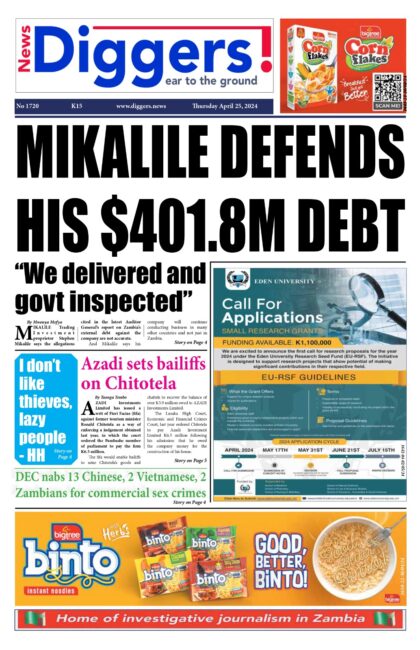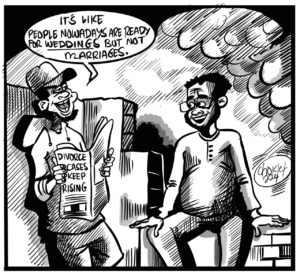There is no doubt that Zambia’s debt is rising dramatically. In 2011, total debt was recorded at US$3.5 billion and has risen to $US14.4 billion as of March 2018. These debt levels are alarming: it’s been almost one year since the IMF declared Zambia at high risk of debt distress, and in this time debt has risen significantly up the domestic news agenda. Zambia’s debt risk has also made international news, with the Economist running two articles on Zambia’s debt in a recent edition.
However, more often than not, the people that talk about debt are economists. Talk of bond yields, debt to GDP ratio, foreign exchange reserves and exchange rate risk is important but can be confusing. But we all need to discuss debt as it affects individuals, businesses and public services. Over the next six weeks, CUTS will explore why Zambia’s debt should concerns us all – what it is and why it matters. We believe Zambia could be on its way to a full debt crisis, but we also believe that as a country we have time to act to prevent this. So we want to take this opportunity to explain the public debt, what it means and set out why together Zambians – individuals, CSOs and Government – need to work collectively to solve it.
Understanding Zambia’s debt
Zambia’s situation is similar to a household that borrows money beyond its means to repay. Let us give you the example of Mr. Chomba, head of a household, who is married with three children. He earns a monthly salary of K7000 and on average spends K5000 for basic needs such as transport, food, utility bills and so on. The family also has a car – it’s not fancy but it works. However, Mr. Chomba has decided they need a new one and gets a loan from the bank to pay for it. But Mr. Chomba not only owes the bank the money he borrowed, but also has to pay interest. The problem is that over a period of time, the loan repayments exceed his monthly earnings. His family now has less money and cannot afford basic needs because of the burden of paying back the loan. His children have to drop out of school as he cannot afford to pay school fees because he can no longer provide as much as he could for his family. If Mr. Chomba had planned carefully and obtained the loan to invest in a business that would generate more income for his family then getting the loan would have been justified. He would have borrowed to increase his income and eventually pay back his loan. However, he borrowed beyond his means to repay, leaving him and his family in a worse off position than before he got the loan.
Zambia’s debt has not been spent in a way that has increased growth but has become a burden on the economy. Interest payments alone consume a huge proportion of the national budget. Total domestic Government revenue – the money the government makes from taxes, fees and levies – was K39.2 billion in 2017 (Zambia Revenue Authority 2017 Annual Report). Meanwhile, Zambia’s interest payments to service its debt in 2017 was K9.8 billion (Ministry of Finance, 2018). This means that interest payments – often called ‘debt servicing’ costs – amount to 25% of the Government’s revenue. This is equivalent to the total health, social protection and Farmer Input Support Program (FISP) budget allocations for the 2017 national budget. As debt rises, these payments will increase.
Why does debt matter?
High debt levels leave Zambia in a very difficult position. A lot of the country’s debt is contracted in foreign currency which means if the kwacha weakens due to external factors, such as the copper price falling unexpectedly, the amount that Zambia owes in real terms will increase significantly. High debt servicing costs debt weaken the economy by forcing the government to spend money on interest payments when it should be spending on national development. Health, education, social protection are just three areas which are significantly impacted, as money spent on interest cannot be spent on these sectors. A lack of investment in these services has a long-term impact on the social well-being of Zambians. High debt levels also leave the Government unable to pay its obligations to companies and contractors who have been engaged for various development projects: this is called payment arrears and at the moment Government owes K13.9 billion. We will discuss the impact of arrears and public debt in general on businesses in more detail later in the series.
The impact of high debt levels should concern everyone, as everyone will be affected whether by businesses closing, or hospitals lacking medicine. Amid all the debate, there is no doubt that debt in Zambia is increasing at an alarming rate. Zambians will be the first to pay the real price for the country’s debt, as our social services are underinvested and economy weakens. On Friday 18 September, the Government will be announcing the 2019 budget, and we will see the direct impact of debt servicing on social services.
CUTS is therefore, actively working to get more transparent information from government on the reality of Zambia’s debt. Follow this series to find out more over the next six weeks, and follow the conversation on social media #DebtConcernsMe.












